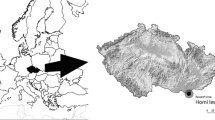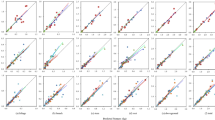Abstract
Branch knots and other traces of lateral axes, known as rameal traces, have generally been disregarded within architectural studies based on external observations and their analysis limited to tedious manual dissection methods. Based on non-destructive methods including X-ray CT scanning (XRCTS) and on the ontogenic knowledge progressively accumulated on Quercus petraea, this paper presents (1) the tracking methodology of all rameal traces with XRCTS and the “Gourmands” plugin, and software created downstream, notably the 3D visualisation software “Bil3D”; (2) preliminary results obtained on two Quercus petraea 50 cm-long logs; and (3) potential applications in the fields of biology and ecology. Of approximately 45 sequences of linked rameal traces (composing rameal sequences) per metre, half were directly connected to the pith as horizontal traces of primary epicormic buds, while the other half were connected to a branch by an oblique knot. Horizontal epicormic knots essentially emerged within the tree from the most intensive thinning treatment and led to additional knots in the clear wood. Secondary epicormic shoots may emerge from branch and epicormic knots, leading to a vertical spread of epicormic sites for the former and to more bud clusters for the latter. Engulfment of lateral axes can be quantified. Assumptions on the origin of between-tree variability are proposed. Our methodology opens the way to an exhaustive description of rameal traces. It is relevant for ontogenic and wood quality assessment at the trunk level. It may also be very useful for characterising the potentiality of reiteration and for repairing shoot damage and vegetative regeneration at the crown, collar and even root system level.






Similar content being viewed by others
References
Andreu JP, Rinnhofer A (2003) Modeling knot geometry in Norway spruce from industrial CT images. Conference information. In: 13th Scandinavian Conference on Image Analysis (SCIA 2003), Jun 29–Jul 02, Halmstad, Sweden. Image Analysis, Proceedings (2749) 786–791
Andrews SR, Gill LS (1939) Determining the time branches on living trees have been dead. J For 37:930–935
Barthélémy D, Caraglio Y (2007) Plant architecture: a dynamic, multilevel and comprehensive approach to plant form, structure and ontogeny. Ann Bot 99:375–407
Barthélémy D, Sabatier S, Pascal O (1997) Le développement architectural du Noyer noir Juglans nigra L. (Juglandaceae). Forêt Entrep 115:40–47
Benjamin JG, Kershaw JA, Weiskittel AR, Chui YH, Zhang SY (2009) External knot size and frequency in black spruce trees from an initial spacing trial in Thunder Bay, Ontario. For Chron 85:618–624
Bernsten CM (1961) Pruning and epicormic branching in red alder. J For 59:675–676
Björklund L, Petersson H (1999) Predicting knot diameter of Pinus sylvestris in Sweden. Scand J For Res 14:376–384
BS EN 975-1:2009 Sawn timber. Appearance grading of hardwoods. Oak and beech, 30 April 2009
Caraglio Y, Edelin Y (1990) Architecture et dynamique de la croissance du platane, Platanus hydrida Brot. (Platanaceae) {syn. Platanus acerifolia (Aiton) Willd.}. Bulletin de la Société Botanique de France. Lett Botaniques 137:279–291
Church TW, Godman RM (1966) The formation and development of dormant buds in sugar maple. For Sci 12:301–306
Colin F, Robert N, Druelle JL, Fontaine F (2008) Initial spacing has little influence on transient epicormic shoots in a 20-year-old sessile oak plantation. Ann For Sci 65:508–517
Colin F, Ducousso A, Fontaine F (2010a) Epicormics in 13-year-old Quercus petraea: small effect of provenance and large influence of branches and growth unit limits. Ann For Sci 67:312–323
Colin F, Mechergui R, Dhôte JF, Fontaine F (2010b) Epicormic ontogeny on sessile oak trunks and thinning effects quantified with the epicormic composition. Ann For Sci (in press)
Courraud R (1987) Les gourmands sur les chênes “rouvre” et “pédonculé”. Forêt Entreprise 45:20–33
Creber GT, Collinson ME (2006) Epicormic shoot traces in the secondary xylem of the Triassic and Permian fossil conifer species Woodworthia arizonica. IAWA J 27:237–241
Del Tredici P (2001) Sprouting in temperate trees: a morphological and ecological review. Bot Rev 67:121–140
Dietrich G (1973) Untersuchungen über die Astbildung und natûrliche Astreinigung der Weisstanne. Forstwissenschatliche Forschungen 34:1–95
Fink S (1980) Anatomische Untersuchungen über das Vorkommen von Spross- und Wurzelanlagen im Stammbereich von Laub- und NadelBäumen. Allg Forst-u J-Ztg, 151, Jg. 9, 160–182
Fink S (1999) Pathological and regenerative plant anatomy. Encyclopedia of plant anatomy Bd. 14, Teil 6. Borntraeger Berlin Stuttgart
Fontaine F, Druelle JL, Clément C, Burrus M, Audran JC (1998) Ontogeny of proventitious epicormic buds in Quercus petraea. I. In the five years following initiation. Tree Struct Funct 13:54–62
Fontaine F, Kiefer E, Clément C, Burrus M, Druelle JL (1999) Ontogeny of proventitious epicormic buds in Quercus petraea. II. From 6 to 40 years of the tree’s life. Tree Struct Funct 14:83–90
Fontaine F, Colin F, Jarret P, Druelle JL (2001) Evolution of the epicormic potential on 17-year-old Quercus petraea trees: first results. Ann For Sci 58:583–592
Fontaine F, Mothe F, Colin F, Duplat P (2004) Structural relationships between the epicormic formations on trunk surface and defects induced in the wood of Quercus petraea. Tree Struct Funct 18:295–306
Freyburger C, Longuetaud F, Mothe F, Constant T, Leban JM (2009) Measuring wood density by means of X-rays computer tomography. Ann For Sci 66:804–813
Fujimori T (1993) Dynamics of crown structure and stem growth based on knot analysis of a Hinocki Cypress. For Ecol Manag 56:57–68
Funt BV, Bryant EC (1987) Detection of internal log defects by automatic interpretation of computer-tomography images. For Prod J 37:56–62
Godin C, Caraglio Y (1998) A multiscale model of plant topological structures. J Theoret Biol 191:1–46
Godin C, Costes E, Sinoquet H (1999) A method for describing plant architecture which integrates topology and geometry. Ann Bot 84:343–357
Grah RF (1961) Relationship between tree spacing, knot size, and log quality in young douglas-fir stands. J For 59:270–272
Hallé F, Oldemann R (1970) Essai sur l’architecture et la dynamique de croissance des arbres tropicaux. Masson & Cie Ed, 178 pp
Hartig T (1878) Anatomie und Physiologie der Holzpflanzen. Berlin
Hein S, Spiecker H (2007) Comparative analysis of occluded branch characteristics for Fraxinus excelsior and Acer pseudoplatanus with natural and artificial pruning. Can J For Res 37:1414–1426
Heuret P, Barthélémy D, Nicolini E, Atger C (2000) Analysis of height growth factors and trunk development in the sessile oak, Quercus petraea (Matt.) Liebl. (Fagaceae) in dynamic sylviculture. Can J Bot 78:361–373
Heuret P, Guédon Y, Guérard N, Barthélémy D (2003) Analysing branching pattern in plantations of young red oak trees (Quercus rubra L., Fagaceae). Ann Bot 91:479–492
Kauppi A, Rinne P, Ferm A (1987) Initiation, structure and sprouting of dormant basal buds in Betula pubescens. Flora 179:55–83
Kershaw JA, Benjamin JG, Weiskittel AR (2009) Approaches for modelling vertical distribution of maximum knot size in black spruce: a comparison of fixed- and mixed-effects nonlinear models. For Sci 55:230–237
Koehler A (1936) A method of studying knot formation. J For 34:1062–1063
Kormanik PP, Brown CL (1967) Origin and development of epicormic branches in sweetgum. USDA Forest Service, Research Paper SE-54:1–17
Lang GA (1987) Dormancy: a new universal terminology. HortScience 22:817–820
Lemieux H, Samson M, Usenius A (1997a) Shape and distribution of knots in a sample of Picea abies logs. Scand J For Res 12:50–56
Lemieux H, Samson M, Usenius A (1997b) Shape and distribution of knots in a sample of Picea abies logs. Scand J For Res 12:50–56
Lemieux H, Beaudoin M, Zhang SY (2001) Characterization and modeling of knots in black spruce (Picea mariana) logs. Wood Fiber Sci 33:465–475
Longuetaud F, Caraglio Y (2009) Pith: a marker of primary growth in Picea abies (L.) Karst. Tree Struct Funct 23:325–334
Longuetaud F, Saint-Andre L, Leban JM (2005) Automatic detection of annual growth units on Picea abies logs using optical and X-ray techniques. J non destr eval 24:29–43
Lundgren C (2000) Predicting log type and knot size category using external log shape data from a 3D log scanner. Scand J For Res 15:119–126
Maguire DA, Hann DW (1987) A stem dissection technique for dating branch mortality and reconstructing past crown recession. For Sci 33:858–871
Mayer-Wegelin H (1936) Ästung, Schaper-Verlag, Hannover
Nicolini E, Caraglio Y (1994) Influence of various architectural characteristics on the development of forked axis in Fagus sylvatica as function of canopy presence. Can J Bot 72:1723–1734
Ningre F, Colin F (2007) Frost damage on the terminal shoot as a risk factor of fork incidence on common beech (Fagus sylvatica L.). Ann For Sci 64:79–86
Nordmark U (2003) Models of knots and log geometry of young Pinus sylvestris sawlogs extracted from computed tomographic images. Scand J For Res 18:168–175
Oja J (1997) A comparison between three different methods of measuring knot parameters in Picea abies. Scand J For Res 12:311–315
Oja J (2000) Evaluation of knot parameters measured automatically in CT-images of Norway spruce (Picea abies (L.) Karst.). Holz als Roh- und Werkstoff 58:375–379
Petruncio M, Briggs D, Barbour RJ (1997) Predicting pruned branch stub occlusion in young, coastal Douglas-fr. Can J For Res 27:1074–1082
Pinto I, Pereira H, Usenius A (2003) Analysis of log shape and internal knots in twenty maritime pine (Pinus pinaster Ait.) stems based on visual scanning and computer aided reconstruction. Ann For Sci 60:137–144
Rapraeger EF (1939) Development of branches and knots in Western White Pine. J For 37:239–245
Rey-Lescure E (1982) The distribution of epicormic branches on the bole of 25 species bordering clearcut stripes. Can J For Res 12:687–698
Romberger JA (1963) Meristems, growth, and development in woody plants. An analytical review of anatomical, physiological, and morphogenic aspects. US Dept. Agriculture Technical Bulletin No. 1293:1–214
Schöpf J (1954) Untersuchungen über Astbildung und Astreinigung der Selber Kiefer. Forsrwissenschaftliches Centralbau 73:275–289
Spathelf P (2003) Reconstruction of crown length of Norway spruce (Picea abies L. Karst.) and Silver fir (Abies alba Mill.)—technique, establishment of sample methods and application in forest growth analysis. Ann For Sci 60:833–842
Spiecker H (1991) Zur Steuerung des Dickenwachstums und der Astreinigung von Trauben-und Stieleichen (Quercus petraea (Matt.) Liebl. und Quercus robur L.). Schriftenreihe der Landesforstverwaltung, Band 72, 150 p
Vestol G, Colin F, Loubère M (1999) Influence of progeny and initial stand density on the relationship between diameter at breast height and knot diameter of Picea abies. Scand J For Res 14:470–480
Wignall TA, Browning G, Mackenzie KAD (1987) The physiology of epicormic emergence in pedunculate oak (Quercus robur L.): responses to partial notch girdling in thinned and unthinned stands. Forestry 60:45–56
Yokoi S, Yamaguchi K (1996) Origin of epicormic branches and effect of thinning on their development in Quercus mongolica var. grosseserrata. J Jpn For Soc 78:169–174
Acknowledgments
We thank Bruno Chopard, forest engineer at “Office National des Forêts”, for providing wood material and for managing the experimental stand.
Author information
Authors and Affiliations
Corresponding author
Additional information
Communicated by R. Matyssek.
Rights and permissions
About this article
Cite this article
Colin, F., Mothe, F., Freyburger, C. et al. Tracking rameal traces in sessile oak trunks with X-ray computer tomography: biological bases, preliminary results and perspectives. Trees 24, 953–967 (2010). https://doi.org/10.1007/s00468-010-0466-1
Received:
Revised:
Accepted:
Published:
Issue Date:
DOI: https://doi.org/10.1007/s00468-010-0466-1




